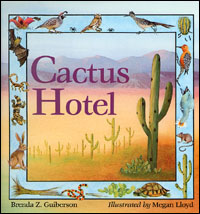Expanding students’ knowledge from their own environment to the various other environments of the country and the world can often be a challenge. Students are often unaware of the different characteristics and species that compose other habitats. Brenda Z. Guiberson’s book Cactus Hotel, illustrated by Megan Lloyd, details the life cycle of a cactus and the characteristics and species that compose a desert habitat.
The gradual progression, spanning from the unintentional planting of a fruit seed by an animal to the use of a two-hundred and fifty year old decaying cactus by animals for protection, emphasizes the multiple stages and adaptations that occur throughout the plant’s life-cycle. With each page Guiberson introduces the reader to a new step in the life cycle of the plant. This organization helps to demonstrate to students the extensive time frame it takes for plant growth in addition to the adaptations the plant and other species must make in the desert environment.
Guiberson and Lloyd demonstrate in their book the interdependence among a habitat by showing how the cactus is not just a component of the environment but it also houses many species in its “hotel” throughout its life cycle. This connection to a hotel stay, along with the vocabulary used, allows students to comprehend what a cactus or other organism provides to the overall habitat.
Everybody wants to live in the cactus hotel. Birds lay eggs and pack rats raise their young. Even insects and bats live there. When one animal moves out, another moves in. And every spring they come for a special treat of nectar and juicy red fruit.
This book will help familiarize students with a particular environment that they may be unfamiliar to, but all students will benefit from the additional connections that Cactus Hotel provides through explaining in detail and with examples how all species and organisms depend on one another in an environment.
Curriculum Connections
Guiberson and Lloyd’s book is great for a wide range of children from first grade through fourth grade. This book gives details that could be further explored in the upper elementary grades with a study of adaptations, life-cycles (In Virginia 4.5) and specific dry-land environments (3.6d). When used in first and second grade classrooms Cactus Hotel correlates to the standards relating to the life needs of plants and animals (1.4, 1.5) and the interdependence among these needs (2.5).
Additional Resources
- A hands-on experiment where students can investigate how a cactus adapts its size based on the amount of water available.
- A to Z Teacher Stuff provides lesson plans, activities, and experiments for a desert habitat unit.
- This site contains various science videos (including habitats and the desert) which students can watch followed by corresponding quizzes, vocabulary, activities and games.
Book: Cactus Hotel
Author: Brenda Z. Guiberson
Illustrator: Megan Lloyd
Publisher: Henry Holt and Co.
Publication Date: 1993
Pages: 32 pages
Grades: First Grade-Fourth Grade
ISBN: 0805029605

